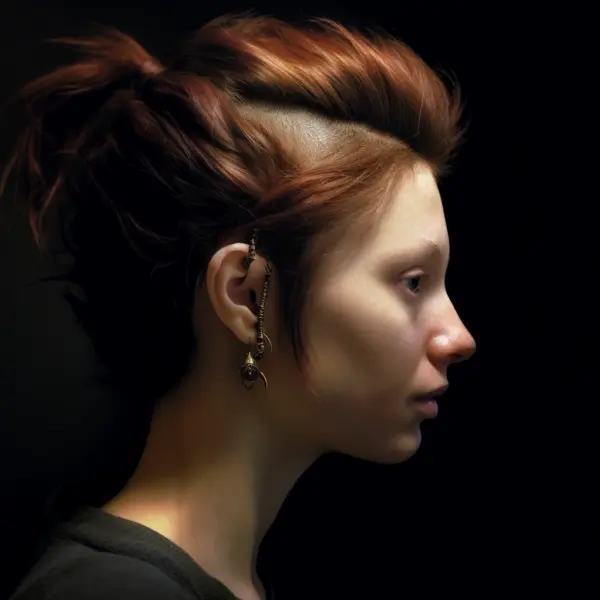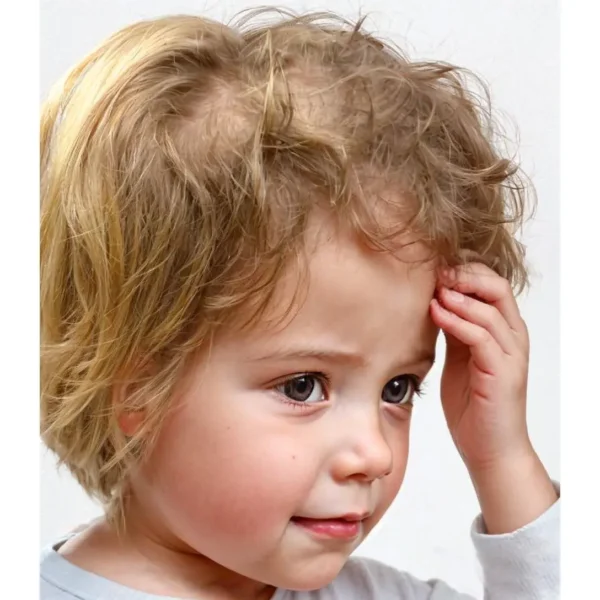The question of whether hats cause hair loss is a topic of interest and concern for many individuals. This article aims to explore the relationship between hat wearing and hair loss, examining scientific evidence and expert opinions to provide a comprehensive answer. Hair loss, or alopecia, can result from various factors, including genetics, hormonal changes, medical conditions, and lifestyle choices. The impact of external factors such as hat wearing has been a subject of debate among researchers and healthcare professionals. This article will delve into how wearing hats may or may not contribute to hair loss.
Where did the Idea Come from that Hats Cause Hair Loss: The idea that hats cause hair loss probably came from medical doctors in the 19th Century. Several books and medical journal articles proposed that tight hats restricted blood supply and over time caused hair loss. As one example, Dr. A.F.A. King made some remarks at a meeting of the Clinico-Pathological Society of Washington, D. C., in 1868. He proposed that impeding blood circulation through the scalp skin was due to compression, either partial or complete, of the arteries supplying the scalp, and this was due to the pressure of tight-fitting hats. For his evidence, he mainly relied upon his observation of the greater frequency with which hair loss occurred in men as compared to women, and hats being worn as a general rule only by men (his claim).
Dr. King also claimed the reason why baldness occurred in different localities in different individuals was, probably, due to a “difference in the shape of the head”. He claimed a long skull, when the pressure would be most exerted on the forehead (and, consequently, on the anterior temporal arteries) and occiput (back of the head), would lose its hair sooner from the top and anterior area. “When a patch of baldness exists about the vertex, we might expect to find a wide head, the posterior temporal arteries, which supply the locality referred to, being compressed against the parietal bones. Below the hat rim, when the circulation is not impeded, we invariably find the hair to remain good, though the top of the head may, at the same time, be entirely bald.”
As a prophylactic measure, Dr. K. recommended the manufacture of hats made “so as to embrace the head at points or surfaces where no considerable vessel would be compressed, or hats made to order for each individual might be arranged with a notch or semi-circular concavity in the rim over the spot of skin under which the artery passed.” Unfortunately the idea that hats cause hair loss seems to have taken hold in the medical profession as well as with the general population in the 19th Century.
The Role of Hats in Hair Loss: The notion that hats cause hair loss stems from a belief that regular hat wearing could lead to direct physical damage to hair follicles, reduced blood flow to the scalp, or provide an environment that increases the risk of scalp conditions that cause alopecia (such as dandruff for example). However, scientific evidence to support these claims does not exist. Only one modern medical research article has directly addressed the possibility of hats and similar causing hair loss, but the research did not find any significant difference in hair loss between people who wore headgear and those who did not. Despite this lack of evidence, the idea that hats cause hair loss might persist in modern culture due to the fact that first onset of pattern alopecia most commonly occurs at around about the same age (early 20s) when people become active in the military and other professions where wearing headgear is part of the job. This apparent association is mostly just a coincidence of timing – though there are some specific instances where headgear can cause hair loss (see below).
Physical Damage and Traction Alopecia: Traction alopecia is a form of hair loss caused by constant pulling or tension on the hair follicles, most typically due to certain hairstyles like braids or tight ponytails. While hats themselves are not likely to exert enough tension to cause this condition, very tight hats or those worn in such a way that they pull on the hair could potentially contribute to traction alopecia over time. There is at least one study from South Korea that identifies “nurse cap alopecia” as a problem in nurses where caps are attached to the hair using hair clips. From the airline industry, it seems that flight caps which are pinned to the hair can also cause alopecia.
There are also some reports of sports and military personnel having problems with poorly fitting helmets pulling on hair and causing hair loss over time. It should also be noted that women in the military can have a problem with traction alopecia as there is a general expectation of hairstyling that involves pulling hair into a tight ponytail. Intriguingly, there is a medical article that indicates traction alopecia has been reported in women who jogged daily, wearing tight-banded wide-stripped heavy headphone gear. However, so long as a hat or other headgear is not pulling on the hair in some way, it should not cause alopecia.
Blood Flow to the Scalp: Another long-standing theory suggests that hats might restrict blood flow to the scalp, thereby affecting hair growth. However, there is no substantial evidence to support the idea that wearing hats under normal conditions significantly impacts scalp blood circulation to the extent that it would cause hair loss. Even a stiff hat on a typical head causes no pressure on the location of the external carotid artery in its passage to supply the scalp skin and hair follicles. The blood vessels supplying scalp skin are also located quite deep such that quite extreme pressure would be needed to really restrict blood supply.
Scalp Health: Wearing hats and helmets, especially if they are not clean or if worn in hot and sweaty conditions, can create an environment that may exacerbate scalp conditions, such as seborrheic dermatitis or scalp acne. While these conditions can lead to temporary hair loss, they do not directly cause permanent hair loss. Maintaining scalp hygiene and choosing breathable, clean hats can mitigate these risks. Today, most dermatologists, trichologists and hair loss experts agree that wearing hats does not cause hair loss. The consensus is that hat wearing is unlikely to be a significant factor in hair loss unless accompanied by other detrimental conditions or behaviors.
Conclusion: The evidence does not support the notion that hats directly cause hair loss. While certain practices related to hat and headgear wearing can potentially contribute to hair loss under specific circumstances, such as wearing very tight hats that cause traction alopecia or neglecting scalp hygiene, these are not direct consequences of the act of wearing a hat. Genetic factors, hormonal changes, medical conditions, tight hairstyles, and certain medications are the underlying culprits behind most cases of hair loss that are initially attributed to hat wearing. For individuals concerned about hair loss, focusing on maintaining a healthy scalp, avoiding hairstyles that put excessive tension on hair follicles, and seeking medical advice for underlying conditions are more effective strategies than simply avoiding hats. As always, if there are concerns about hair loss, consulting with a healthcare professional or dermatologist can provide personalized advice and treatment options based on individual health profiles and needs.
Bibliography
11711645 {11711645:K782QUUP},{11711645:8IIE8EP7},{11711645:BVGNCUP8},{11711645:5K7SKP8R},{11711645:JQ7VGDQW},{11711645:9UUWTQWJ},{11711645:C99I7EFA},{11711645:DE66BZWJ},{11711645:RTR7JUR7},{11711645:EGS6RE2Q},{11711645:6JMMVXJM},{11711645:T2KSA79F},{11711645:PBAUECM8},{11711645:SBRHXHJR},{11711645:AK5NVN3W},{11711645:TDU4PHNV} 1 vancouver 50 date asc 1164 https://www.keratin.com/wp-content/plugins/zotpress/ %7B%22status%22%3A%22success%22%2C%22updateneeded%22%3Afalse%2C%22instance%22%3Afalse%2C%22meta%22%3A%7B%22request_last%22%3A0%2C%22request_next%22%3A0%2C%22used_cache%22%3Atrue%7D%2C%22data%22%3A%5B%7B%22key%22%3A%22AK5NVN3W%22%2C%22library%22%3A%7B%22id%22%3A11711645%7D%2C%22meta%22%3A%7B%22creatorSummary%22%3A%22Flint%22%2C%22parsedDate%22%3A%221853-03%22%2C%22numChildren%22%3A0%7D%2C%22bib%22%3A%22%26lt%3Bdiv%20class%3D%26quot%3Bcsl-bib-body%26quot%3B%20style%3D%26quot%3Bline-height%3A%201.35%3B%20%26quot%3B%26gt%3B%5Cn%20%20%26lt%3Bdiv%20class%3D%26quot%3Bcsl-entry%26quot%3B%20style%3D%26quot%3Bclear%3A%20left%3B%20%26quot%3B%26gt%3B%5Cn%20%20%20%20%26lt%3Bdiv%20class%3D%26quot%3Bcsl-left-margin%26quot%3B%20style%3D%26quot%3Bfloat%3A%20left%3B%20padding-right%3A%200.5em%3B%20text-align%3A%20right%3B%20width%3A%201em%3B%26quot%3B%26gt%3B1.%26lt%3B%5C%2Fdiv%26gt%3B%26lt%3Bdiv%20class%3D%26quot%3Bcsl-right-inline%26quot%3B%20style%3D%26quot%3Bmargin%3A%200%20.4em%200%201.5em%3B%26quot%3B%26gt%3BFlint%20A.%20Hats%20and%20baldness.%20Buffalo%20Medical%20Journal.%201853%20Mar%3B8%2810%29%3A649%26%23x2013%3B51.%26lt%3B%5C%2Fdiv%26gt%3B%5Cn%20%20%20%26lt%3B%5C%2Fdiv%26gt%3B%5Cn%26lt%3B%5C%2Fdiv%26gt%3B%22%2C%22data%22%3A%7B%22itemType%22%3A%22journalArticle%22%2C%22title%22%3A%22Hats%20and%20baldness%22%2C%22creators%22%3A%5B%7B%22creatorType%22%3A%22author%22%2C%22firstName%22%3A%22Austin%22%2C%22lastName%22%3A%22Flint%22%7D%5D%2C%22abstractNote%22%3A%22%22%2C%22date%22%3A%221853-03%22%2C%22language%22%3A%22%22%2C%22DOI%22%3A%22%22%2C%22ISSN%22%3A%22%22%2C%22url%22%3A%22%22%2C%22collections%22%3A%5B%22FCV6IX6G%22%5D%2C%22dateModified%22%3A%222024-02-07T20%3A56%3A44Z%22%7D%7D%2C%7B%22key%22%3A%22DE66BZWJ%22%2C%22library%22%3A%7B%22id%22%3A11711645%7D%2C%22meta%22%3A%7B%22creatorSummary%22%3A%22King%22%2C%22parsedDate%22%3A%221868%22%2C%22numChildren%22%3A0%7D%2C%22bib%22%3A%22%26lt%3Bdiv%20class%3D%26quot%3Bcsl-bib-body%26quot%3B%20style%3D%26quot%3Bline-height%3A%201.35%3B%20%26quot%3B%26gt%3B%5Cn%20%20%26lt%3Bdiv%20class%3D%26quot%3Bcsl-entry%26quot%3B%20style%3D%26quot%3Bclear%3A%20left%3B%20%26quot%3B%26gt%3B%5Cn%20%20%20%20%26lt%3Bdiv%20class%3D%26quot%3Bcsl-left-margin%26quot%3B%20style%3D%26quot%3Bfloat%3A%20left%3B%20padding-right%3A%200.5em%3B%20text-align%3A%20right%3B%20width%3A%201em%3B%26quot%3B%26gt%3B1.%26lt%3B%5C%2Fdiv%26gt%3B%26lt%3Bdiv%20class%3D%26quot%3Bcsl-right-inline%26quot%3B%20style%3D%26quot%3Bmargin%3A%200%20.4em%200%201.5em%3B%26quot%3B%26gt%3BKing%20AFA.%20On%20the%20causes%20of%20alopecia%2C%20and%20its%20greater%20frequency%20in%20males%20than%20females.%20Am%20J%20Med%20Sci.%201868%3B55%2813%29%3A416%26%23x2013%3B8.%26lt%3B%5C%2Fdiv%26gt%3B%5Cn%20%20%20%26lt%3B%5C%2Fdiv%26gt%3B%5Cn%26lt%3B%5C%2Fdiv%26gt%3B%22%2C%22data%22%3A%7B%22itemType%22%3A%22journalArticle%22%2C%22title%22%3A%22On%20the%20causes%20of%20alopecia%2C%20and%20its%20greater%20frequency%20in%20males%20than%20females%22%2C%22creators%22%3A%5B%7B%22creatorType%22%3A%22author%22%2C%22firstName%22%3A%22A.%20F.%20A.%22%2C%22lastName%22%3A%22King%22%7D%5D%2C%22abstractNote%22%3A%22%22%2C%22date%22%3A%221868%22%2C%22language%22%3A%22%22%2C%22DOI%22%3A%22%22%2C%22ISSN%22%3A%22%22%2C%22url%22%3A%22%22%2C%22collections%22%3A%5B%22FCV6IX6G%22%5D%2C%22dateModified%22%3A%222024-02-07T21%3A47%3A15Z%22%7D%7D%2C%7B%22key%22%3A%225K7SKP8R%22%2C%22library%22%3A%7B%22id%22%3A11711645%7D%2C%22meta%22%3A%7B%22creatorSummary%22%3A%22Eaton%22%2C%22parsedDate%22%3A%221886%22%2C%22numChildren%22%3A0%7D%2C%22bib%22%3A%22%26lt%3Bdiv%20class%3D%26quot%3Bcsl-bib-body%26quot%3B%20style%3D%26quot%3Bline-height%3A%201.35%3B%20%26quot%3B%26gt%3B%5Cn%20%20%26lt%3Bdiv%20class%3D%26quot%3Bcsl-entry%26quot%3B%20style%3D%26quot%3Bclear%3A%20left%3B%20%26quot%3B%26gt%3B%5Cn%20%20%20%20%26lt%3Bdiv%20class%3D%26quot%3Bcsl-left-margin%26quot%3B%20style%3D%26quot%3Bfloat%3A%20left%3B%20padding-right%3A%200.5em%3B%20text-align%3A%20right%3B%20width%3A%201em%3B%26quot%3B%26gt%3B1.%26lt%3B%5C%2Fdiv%26gt%3B%26lt%3Bdiv%20class%3D%26quot%3Bcsl-right-inline%26quot%3B%20style%3D%26quot%3Bmargin%3A%200%20.4em%200%201.5em%3B%26quot%3B%26gt%3BEaton%20VT.%20A%20bald%20and%20toothless%20future.%20Pop%20Sci%20Mon.%201886%3B29%28October%29%3A803%26%23x2013%3B6.%26lt%3B%5C%2Fdiv%26gt%3B%5Cn%20%20%20%26lt%3B%5C%2Fdiv%26gt%3B%5Cn%26lt%3B%5C%2Fdiv%26gt%3B%22%2C%22data%22%3A%7B%22itemType%22%3A%22journalArticle%22%2C%22title%22%3A%22A%20bald%20and%20toothless%20future%22%2C%22creators%22%3A%5B%7B%22creatorType%22%3A%22author%22%2C%22firstName%22%3A%22Virgil%20T.%22%2C%22lastName%22%3A%22Eaton%22%7D%5D%2C%22abstractNote%22%3A%22%22%2C%22date%22%3A%221886%22%2C%22language%22%3A%22eng%22%2C%22DOI%22%3A%22%22%2C%22ISSN%22%3A%22%22%2C%22url%22%3A%22%22%2C%22collections%22%3A%5B%22FCV6IX6G%22%5D%2C%22dateModified%22%3A%222024-02-05T20%3A45%3A43Z%22%7D%7D%2C%7B%22key%22%3A%22SBRHXHJR%22%2C%22library%22%3A%7B%22id%22%3A11711645%7D%2C%22meta%22%3A%7B%22creatorSummary%22%3A%22Gouinlock%22%2C%22parsedDate%22%3A%221887-05%22%2C%22numChildren%22%3A0%7D%2C%22bib%22%3A%22%26lt%3Bdiv%20class%3D%26quot%3Bcsl-bib-body%26quot%3B%20style%3D%26quot%3Bline-height%3A%201.35%3B%20%26quot%3B%26gt%3B%5Cn%20%20%26lt%3Bdiv%20class%3D%26quot%3Bcsl-entry%26quot%3B%20style%3D%26quot%3Bclear%3A%20left%3B%20%26quot%3B%26gt%3B%5Cn%20%20%20%20%26lt%3Bdiv%20class%3D%26quot%3Bcsl-left-margin%26quot%3B%20style%3D%26quot%3Bfloat%3A%20left%3B%20padding-right%3A%200.5em%3B%20text-align%3A%20right%3B%20width%3A%201em%3B%26quot%3B%26gt%3B1.%26lt%3B%5C%2Fdiv%26gt%3B%26lt%3Bdiv%20class%3D%26quot%3Bcsl-right-inline%26quot%3B%20style%3D%26quot%3Bmargin%3A%200%20.4em%200%201.5em%3B%26quot%3B%26gt%3BGouinlock%20WC.%20Hats%20as%20a%20cause%20of%20baldness.%20Popular%20Science%20Monthly.%201887%20May%3B31%287%29%3A97%26%23x2013%3B100.%26lt%3B%5C%2Fdiv%26gt%3B%5Cn%20%20%20%26lt%3B%5C%2Fdiv%26gt%3B%5Cn%26lt%3B%5C%2Fdiv%26gt%3B%22%2C%22data%22%3A%7B%22itemType%22%3A%22journalArticle%22%2C%22title%22%3A%22Hats%20as%20a%20cause%20of%20baldness%22%2C%22creators%22%3A%5B%7B%22creatorType%22%3A%22author%22%2C%22firstName%22%3A%22W.%20C.%22%2C%22lastName%22%3A%22Gouinlock%22%7D%5D%2C%22abstractNote%22%3A%22%22%2C%22date%22%3A%221887-05%22%2C%22language%22%3A%22%22%2C%22DOI%22%3A%22%22%2C%22ISSN%22%3A%22%22%2C%22url%22%3A%22%22%2C%22collections%22%3A%5B%22FCV6IX6G%22%5D%2C%22dateModified%22%3A%222024-02-07T21%3A06%3A38Z%22%7D%7D%2C%7B%22key%22%3A%22T2KSA79F%22%2C%22library%22%3A%7B%22id%22%3A11711645%7D%2C%22meta%22%3A%7B%22creatorSummary%22%3A%22Unknown%22%2C%22parsedDate%22%3A%221887-05-05%22%2C%22numChildren%22%3A0%7D%2C%22bib%22%3A%22%26lt%3Bdiv%20class%3D%26quot%3Bcsl-bib-body%26quot%3B%20style%3D%26quot%3Bline-height%3A%201.35%3B%20%26quot%3B%26gt%3B%5Cn%20%20%26lt%3Bdiv%20class%3D%26quot%3Bcsl-entry%26quot%3B%20style%3D%26quot%3Bclear%3A%20left%3B%20%26quot%3B%26gt%3B%5Cn%20%20%20%20%26lt%3Bdiv%20class%3D%26quot%3Bcsl-left-margin%26quot%3B%20style%3D%26quot%3Bfloat%3A%20left%3B%20padding-right%3A%200.5em%3B%20text-align%3A%20right%3B%20width%3A%201em%3B%26quot%3B%26gt%3B1.%26lt%3B%5C%2Fdiv%26gt%3B%26lt%3Bdiv%20class%3D%26quot%3Bcsl-right-inline%26quot%3B%20style%3D%26quot%3Bmargin%3A%200%20.4em%200%201.5em%3B%26quot%3B%26gt%3BUnknown.%20Hats%20as%20a%20cause%20of%20baldness.%20Boston%20Medical%20and%20Surgical%20Journal.%201887%20May%205%3B116%2818%29%3A435%26%23x2013%3B6.%26lt%3B%5C%2Fdiv%26gt%3B%5Cn%20%20%20%26lt%3B%5C%2Fdiv%26gt%3B%5Cn%26lt%3B%5C%2Fdiv%26gt%3B%22%2C%22data%22%3A%7B%22itemType%22%3A%22journalArticle%22%2C%22title%22%3A%22Hats%20as%20a%20cause%20of%20baldness%22%2C%22creators%22%3A%5B%7B%22creatorType%22%3A%22author%22%2C%22firstName%22%3A%22%22%2C%22lastName%22%3A%22Unknown%22%7D%5D%2C%22abstractNote%22%3A%22%22%2C%22date%22%3A%221887-05-05%22%2C%22language%22%3A%22%22%2C%22DOI%22%3A%22%22%2C%22ISSN%22%3A%22%22%2C%22url%22%3A%22%22%2C%22collections%22%3A%5B%22FCV6IX6G%22%5D%2C%22dateModified%22%3A%222024-02-07T21%3A48%3A41Z%22%7D%7D%2C%7B%22key%22%3A%22JQ7VGDQW%22%2C%22library%22%3A%7B%22id%22%3A11711645%7D%2C%22meta%22%3A%7B%22creatorSummary%22%3A%22Elliot%22%2C%22parsedDate%22%3A%221893%22%2C%22numChildren%22%3A0%7D%2C%22bib%22%3A%22%26lt%3Bdiv%20class%3D%26quot%3Bcsl-bib-body%26quot%3B%20style%3D%26quot%3Bline-height%3A%201.35%3B%20%26quot%3B%26gt%3B%5Cn%20%20%26lt%3Bdiv%20class%3D%26quot%3Bcsl-entry%26quot%3B%20style%3D%26quot%3Bclear%3A%20left%3B%20%26quot%3B%26gt%3B%5Cn%20%20%20%20%26lt%3Bdiv%20class%3D%26quot%3Bcsl-left-margin%26quot%3B%20style%3D%26quot%3Bfloat%3A%20left%3B%20padding-right%3A%200.5em%3B%20text-align%3A%20right%3B%20width%3A%201em%3B%26quot%3B%26gt%3B1.%26lt%3B%5C%2Fdiv%26gt%3B%26lt%3Bdiv%20class%3D%26quot%3Bcsl-right-inline%26quot%3B%20style%3D%26quot%3Bmargin%3A%200%20.4em%200%201.5em%3B%26quot%3B%26gt%3BElliot%20GT.%20Alopecia%20prematura%3A%20Its%20most%20frequent%20cause%3B%20Seborrhoeal%20eczema.%20Trans%20Am%20Dermat%20Assoc.%201893%3B16th%20Annual%20Meeting%3A81%26%23x2013%3B99.%26lt%3B%5C%2Fdiv%26gt%3B%5Cn%20%20%20%26lt%3B%5C%2Fdiv%26gt%3B%5Cn%26lt%3B%5C%2Fdiv%26gt%3B%22%2C%22data%22%3A%7B%22itemType%22%3A%22journalArticle%22%2C%22title%22%3A%22Alopecia%20prematura%3A%20Its%20most%20frequent%20cause%3B%20Seborrhoeal%20eczema%22%2C%22creators%22%3A%5B%7B%22creatorType%22%3A%22author%22%2C%22firstName%22%3A%22George%20T.%22%2C%22lastName%22%3A%22Elliot%22%7D%5D%2C%22abstractNote%22%3A%22%22%2C%22date%22%3A%221893%22%2C%22language%22%3A%22eng%22%2C%22DOI%22%3A%22%22%2C%22ISSN%22%3A%22%22%2C%22url%22%3A%22%22%2C%22collections%22%3A%5B%22FCV6IX6G%22%5D%2C%22dateModified%22%3A%222024-02-05T20%3A33%3A58Z%22%7D%7D%2C%7B%22key%22%3A%22TDU4PHNV%22%2C%22library%22%3A%7B%22id%22%3A11711645%7D%2C%22meta%22%3A%7B%22creatorSummary%22%3A%22Selss%22%2C%22parsedDate%22%3A%221897-05%22%2C%22numChildren%22%3A0%7D%2C%22bib%22%3A%22%26lt%3Bdiv%20class%3D%26quot%3Bcsl-bib-body%26quot%3B%20style%3D%26quot%3Bline-height%3A%201.35%3B%20%26quot%3B%26gt%3B%5Cn%20%20%26lt%3Bdiv%20class%3D%26quot%3Bcsl-entry%26quot%3B%20style%3D%26quot%3Bclear%3A%20left%3B%20%26quot%3B%26gt%3B%5Cn%20%20%20%20%26lt%3Bdiv%20class%3D%26quot%3Bcsl-left-margin%26quot%3B%20style%3D%26quot%3Bfloat%3A%20left%3B%20padding-right%3A%200.5em%3B%20text-align%3A%20right%3B%20width%3A%201em%3B%26quot%3B%26gt%3B1.%26lt%3B%5C%2Fdiv%26gt%3B%26lt%3Bdiv%20class%3D%26quot%3Bcsl-right-inline%26quot%3B%20style%3D%26quot%3Bmargin%3A%200%20.4em%200%201.5em%3B%26quot%3B%26gt%3BSelss%20GA.%20Natural%20hair.%20Health%20%5Ba%20Monthly%20Devoted%20to%20the%20Cause%20and%20Cure%20of%20Disease%5D.%201897%20May%3B3%285%29%3A101%26%23x2013%3B5.%26lt%3B%5C%2Fdiv%26gt%3B%5Cn%20%20%20%26lt%3B%5C%2Fdiv%26gt%3B%5Cn%26lt%3B%5C%2Fdiv%26gt%3B%22%2C%22data%22%3A%7B%22itemType%22%3A%22journalArticle%22%2C%22title%22%3A%22Natural%20hair%22%2C%22creators%22%3A%5B%7B%22creatorType%22%3A%22author%22%2C%22firstName%22%3A%22G.%20A.%22%2C%22lastName%22%3A%22Selss%22%7D%5D%2C%22abstractNote%22%3A%22%22%2C%22date%22%3A%221897-05%22%2C%22language%22%3A%22%22%2C%22DOI%22%3A%22%22%2C%22ISSN%22%3A%22%22%2C%22url%22%3A%22%22%2C%22collections%22%3A%5B%22FCV6IX6G%22%5D%2C%22dateModified%22%3A%222024-02-07T20%3A33%3A34Z%22%7D%7D%2C%7B%22key%22%3A%22BVGNCUP8%22%2C%22library%22%3A%7B%22id%22%3A11711645%7D%2C%22meta%22%3A%7B%22creatorSummary%22%3A%22Blaine%22%2C%22parsedDate%22%3A%221899-03-11%22%2C%22numChildren%22%3A0%7D%2C%22bib%22%3A%22%26lt%3Bdiv%20class%3D%26quot%3Bcsl-bib-body%26quot%3B%20style%3D%26quot%3Bline-height%3A%201.35%3B%20%26quot%3B%26gt%3B%5Cn%20%20%26lt%3Bdiv%20class%3D%26quot%3Bcsl-entry%26quot%3B%20style%3D%26quot%3Bclear%3A%20left%3B%20%26quot%3B%26gt%3B%5Cn%20%20%20%20%26lt%3Bdiv%20class%3D%26quot%3Bcsl-left-margin%26quot%3B%20style%3D%26quot%3Bfloat%3A%20left%3B%20padding-right%3A%200.5em%3B%20text-align%3A%20right%3B%20width%3A%201em%3B%26quot%3B%26gt%3B1.%26lt%3B%5C%2Fdiv%26gt%3B%26lt%3Bdiv%20class%3D%26quot%3Bcsl-right-inline%26quot%3B%20style%3D%26quot%3Bmargin%3A%200%20.4em%200%201.5em%3B%26quot%3B%26gt%3BBlaine%20JM.%20Etiology%20of%20alopecia%20prematura.%20Journal%20of%20the%20American%20Medical%20Association.%201899%20Mar%2011%3B32%2810%29%3A524%26%23x2013%3B5.%26lt%3B%5C%2Fdiv%26gt%3B%5Cn%20%20%20%26lt%3B%5C%2Fdiv%26gt%3B%5Cn%26lt%3B%5C%2Fdiv%26gt%3B%22%2C%22data%22%3A%7B%22itemType%22%3A%22journalArticle%22%2C%22title%22%3A%22Etiology%20of%20alopecia%20prematura%22%2C%22creators%22%3A%5B%7B%22creatorType%22%3A%22author%22%2C%22firstName%22%3A%22J.%20M.%22%2C%22lastName%22%3A%22Blaine%22%7D%5D%2C%22abstractNote%22%3A%22In%20a%20paper%20on%20alopecia%20prematura%2C%20read%20before%20the%20Colorado%20State%20Medical%20Society%20three%20years%20ago%2C%20I%20referred%20incidentally%20to%20what%20I%20believed%20to%20be%20the%20true%20cause%20of%20hair%20falling%20in%20young%20men.%20I%20desire%20in%20this%20paper%20to%20confine%20myself%20to%20the%20causes%20alone%2C%20and%20will%20attempt%20to%20show%20that%20in%20most%20cases%20the%20longaccepted%20theories%20as%20to%20causation%20are%20incorrect%2C%20and%20that%2C%20in%20the%20vast%20majority%20of%20instances%2C%20the%20only%20hypothesis%20that%20will%20bear%20the%20searchlight%20of%20investigation%20is%20the%20one%20that%20I%20shall%20here%20set%20forth.In%20symptomatic%20alopecia%20prematura%20the%20causes%20are%20various%2C%20but%20easily%20found.%20If%20falling%20of%20hair%20be%20associated%20with%20any%20visible%20disease%20of%20the%20scalp%20or%20hair%2C%20it%20may%20safely%20be%20regarded%20as%20a%20sequence%20of%20the%20graver%20disease%2C%20and%20not%20per%20se%2C%20the%20disease%20itself.%20The%20variety%20of%20alopecia%20prematura%20about%20which%20we%20have%20heretofore%20known%20nothing%20as%20to%20its%22%2C%22date%22%3A%221899-03-11%22%2C%22language%22%3A%22%22%2C%22DOI%22%3A%2210.1001%5C%2Fjama.1899.92450370010001c%22%2C%22ISSN%22%3A%220002-9955%22%2C%22url%22%3A%22%22%2C%22collections%22%3A%5B%22FCV6IX6G%22%5D%2C%22dateModified%22%3A%222024-02-07T21%3A47%3A51Z%22%7D%7D%2C%7B%22key%22%3A%228IIE8EP7%22%2C%22library%22%3A%7B%22id%22%3A11711645%7D%2C%22meta%22%3A%7B%22creatorSummary%22%3A%22Bergfeld%20and%20Taylor%22%2C%22parsedDate%22%3A%221985%22%2C%22numChildren%22%3A0%7D%2C%22bib%22%3A%22%26lt%3Bdiv%20class%3D%26quot%3Bcsl-bib-body%26quot%3B%20style%3D%26quot%3Bline-height%3A%201.35%3B%20%26quot%3B%26gt%3B%5Cn%20%20%26lt%3Bdiv%20class%3D%26quot%3Bcsl-entry%26quot%3B%20style%3D%26quot%3Bclear%3A%20left%3B%20%26quot%3B%26gt%3B%5Cn%20%20%20%20%26lt%3Bdiv%20class%3D%26quot%3Bcsl-left-margin%26quot%3B%20style%3D%26quot%3Bfloat%3A%20left%3B%20padding-right%3A%200.5em%3B%20text-align%3A%20right%3B%20width%3A%201em%3B%26quot%3B%26gt%3B1.%26lt%3B%5C%2Fdiv%26gt%3B%26lt%3Bdiv%20class%3D%26quot%3Bcsl-right-inline%26quot%3B%20style%3D%26quot%3Bmargin%3A%200%20.4em%200%201.5em%3B%26quot%3B%26gt%3BBergfeld%20WF%2C%20Taylor%20JS.%20Trauma%2C%20sports%2C%20and%20the%20skin.%20American%20J%20Industrial%20Med.%201985%3B8%284%26%23x2013%3B5%29%3A403%26%23x2013%3B13.%26lt%3B%5C%2Fdiv%26gt%3B%5Cn%20%20%20%26lt%3B%5C%2Fdiv%26gt%3B%5Cn%26lt%3B%5C%2Fdiv%26gt%3B%22%2C%22data%22%3A%7B%22itemType%22%3A%22journalArticle%22%2C%22title%22%3A%22Trauma%2C%20sports%2C%20and%20the%20skin%22%2C%22creators%22%3A%5B%7B%22creatorType%22%3A%22author%22%2C%22firstName%22%3A%22Wilma%20F.%22%2C%22lastName%22%3A%22Bergfeld%22%7D%2C%7B%22creatorType%22%3A%22author%22%2C%22firstName%22%3A%22James%20S.%22%2C%22lastName%22%3A%22Taylor%22%7D%5D%2C%22abstractNote%22%3A%22Abstract%20%5Cn%20%20%20%20%20%20%20%20%20%20%20%20Dermatological%20disorders%20in%20atheletes%20may%20occur%20as%20a%20result%20of%20repeated%20mechanical%20trauma%2C%20physical%20and%20chemical%20agents%2C%20climatic%20conditions%2C%20infections%2C%20infestations%2C%20and%20exacerbations%20of%20pre%5Cu2010existing%20skin%20disorders.%20These%20include%20black%20heel%2C%20tennis%20toe%20and%20other%20causes%20of%20subungual%20hemorrhage%2C%20friction%20blisters%2C%20abrasions%2C%20jogger%26%23039%3Bs%20nipples%2C%20alopecia%2C%20calluses%2C%20and%20subcutaneous%20nodules.%20Contact%20dermatitis%20may%20occur%20from%20sports%20equipment%2C%20medications%20used%20to%20treat%20abrasions%2C%20and%20plants%20such%20as%20poison%20ivy%20and%20weeds.%20Herpes%20simplex%20and%20bacterial%20pyoderma%20may%20occur%20in%20wrestlers%20and%20rugby%20players%2C%20especially%20at%20sites%20of%20abrasion.%22%2C%22date%22%3A%2201%5C%2F1985%22%2C%22language%22%3A%22en%22%2C%22DOI%22%3A%2210.1002%5C%2Fajim.4700080422%22%2C%22ISSN%22%3A%220271-3586%2C%201097-0274%22%2C%22url%22%3A%22%22%2C%22collections%22%3A%5B%22FCV6IX6G%22%5D%2C%22dateModified%22%3A%222024-02-07T17%3A43%3A11Z%22%7D%7D%2C%7B%22key%22%3A%22C99I7EFA%22%2C%22library%22%3A%7B%22id%22%3A11711645%7D%2C%22meta%22%3A%7B%22creatorSummary%22%3A%22Hwang%20et%20al.%22%2C%22parsedDate%22%3A%221999-03%22%2C%22numChildren%22%3A0%7D%2C%22bib%22%3A%22%26lt%3Bdiv%20class%3D%26quot%3Bcsl-bib-body%26quot%3B%20style%3D%26quot%3Bline-height%3A%201.35%3B%20%26quot%3B%26gt%3B%5Cn%20%20%26lt%3Bdiv%20class%3D%26quot%3Bcsl-entry%26quot%3B%20style%3D%26quot%3Bclear%3A%20left%3B%20%26quot%3B%26gt%3B%5Cn%20%20%20%20%26lt%3Bdiv%20class%3D%26quot%3Bcsl-left-margin%26quot%3B%20style%3D%26quot%3Bfloat%3A%20left%3B%20padding-right%3A%200.5em%3B%20text-align%3A%20right%3B%20width%3A%201em%3B%26quot%3B%26gt%3B1.%26lt%3B%5C%2Fdiv%26gt%3B%26lt%3Bdiv%20class%3D%26quot%3Bcsl-right-inline%26quot%3B%20style%3D%26quot%3Bmargin%3A%200%20.4em%200%201.5em%3B%26quot%3B%26gt%3BHwang%20SM%2C%20Lee%20WS%2C%20Choi%20EH%2C%20Lee%20SH%2C%20Ahn%20SK.%20Nurse%26%23x2019%3Bs%20cap%20alopecia.%20Int%20J%20Dermatol.%201999%20Mar%3B38%283%29%3A187%26%23x2013%3B91.%26lt%3B%5C%2Fdiv%26gt%3B%5Cn%20%20%20%26lt%3B%5C%2Fdiv%26gt%3B%5Cn%26lt%3B%5C%2Fdiv%26gt%3B%22%2C%22data%22%3A%7B%22itemType%22%3A%22journalArticle%22%2C%22title%22%3A%22Nurse%27s%20cap%20alopecia%22%2C%22creators%22%3A%5B%7B%22creatorType%22%3A%22author%22%2C%22firstName%22%3A%22S.%20M.%22%2C%22lastName%22%3A%22Hwang%22%7D%2C%7B%22creatorType%22%3A%22author%22%2C%22firstName%22%3A%22W.%20S.%22%2C%22lastName%22%3A%22Lee%22%7D%2C%7B%22creatorType%22%3A%22author%22%2C%22firstName%22%3A%22E.%20H.%22%2C%22lastName%22%3A%22Choi%22%7D%2C%7B%22creatorType%22%3A%22author%22%2C%22firstName%22%3A%22S.%20H.%22%2C%22lastName%22%3A%22Lee%22%7D%2C%7B%22creatorType%22%3A%22author%22%2C%22firstName%22%3A%22S.%20K.%22%2C%22lastName%22%3A%22Ahn%22%7D%5D%2C%22abstractNote%22%3A%22BACKGROUND%3A%20Traction%20alopecia%20associated%20with%20the%20nurse%26%23039%3Bs%20cap%20is%20a%20relatively%20common%20form%20of%20occupational%20hair%20loss.%5CnMETHODS%3A%20We%20examined%20199%20healthy%20South%20Korean%20nurses%20to%20assess%20the%20clinical%20and%20pathologic%20characteristics%20of%20traction%20alopecia%20caused%20by%20prolonged%20traction%20exerted%20at%20the%20point%20of%20attachment%20of%20the%20nurse%26%23039%3Bs%20cap.%5CnRESULTS%3A%20Seven%20nurses%20%283.5%25%20of%20199%29%20had%20hair%20loss%20at%20the%20pin%20site%20used%20to%20secure%20the%20nurse%26%23039%3Bs%20cap.%20The%20lesions%20were%20exclusively%20localized%20on%20the%20parieto-occipital%20scalp.%20Histopathologic%20findings%20revealed%20characteristic%20cicatricial%20changes%20which%20showed%20a%20marked%20decrease%20in%20the%20number%20of%20hair%20follicles%20without%20inflammation.%5CnCONCLUSIONS%3A%20Nurse%26%23039%3Bs%20cap%20alopecia%20is%20not%20an%20uncommon%20occupational%20alopecia%2C%20and%20appears%20to%20be%20a%20distinct%20clinical%20entity%20which%20should%20be%20distinguished%20from%20other%20forms%20of%20patchy%20alopecia.%22%2C%22date%22%3A%221999-03%22%2C%22language%22%3A%22eng%22%2C%22DOI%22%3A%2210.1046%5C%2Fj.1365-4362.1999.00556.x%22%2C%22ISSN%22%3A%220011-9059%22%2C%22url%22%3A%22%22%2C%22collections%22%3A%5B%22FCV6IX6G%22%5D%2C%22dateModified%22%3A%222024-02-07T17%3A30%3A07Z%22%7D%7D%2C%7B%22key%22%3A%229UUWTQWJ%22%2C%22library%22%3A%7B%22id%22%3A11711645%7D%2C%22meta%22%3A%7B%22creatorSummary%22%3A%22Gatherwright%20et%20al.%22%2C%22parsedDate%22%3A%222012-12%22%2C%22numChildren%22%3A0%7D%2C%22bib%22%3A%22%26lt%3Bdiv%20class%3D%26quot%3Bcsl-bib-body%26quot%3B%20style%3D%26quot%3Bline-height%3A%201.35%3B%20%26quot%3B%26gt%3B%5Cn%20%20%26lt%3Bdiv%20class%3D%26quot%3Bcsl-entry%26quot%3B%20style%3D%26quot%3Bclear%3A%20left%3B%20%26quot%3B%26gt%3B%5Cn%20%20%20%20%26lt%3Bdiv%20class%3D%26quot%3Bcsl-left-margin%26quot%3B%20style%3D%26quot%3Bfloat%3A%20left%3B%20padding-right%3A%200.5em%3B%20text-align%3A%20right%3B%20width%3A%201em%3B%26quot%3B%26gt%3B1.%26lt%3B%5C%2Fdiv%26gt%3B%26lt%3Bdiv%20class%3D%26quot%3Bcsl-right-inline%26quot%3B%20style%3D%26quot%3Bmargin%3A%200%20.4em%200%201.5em%3B%26quot%3B%26gt%3BGatherwright%20J%2C%20Liu%20MT%2C%20Gliniak%20C%2C%20Totonchi%20A%2C%20Guyuron%20B.%20The%20contribution%20of%20endogenous%20and%20exogenous%20factors%20to%20female%20alopecia%3A%20a%20study%20of%20identical%20twins.%20Plast%20Reconstr%20Surg.%202012%20Dec%3B130%286%29%3A1219%26%23x2013%3B26.%26lt%3B%5C%2Fdiv%26gt%3B%5Cn%20%20%20%26lt%3B%5C%2Fdiv%26gt%3B%5Cn%26lt%3B%5C%2Fdiv%26gt%3B%22%2C%22data%22%3A%7B%22itemType%22%3A%22journalArticle%22%2C%22title%22%3A%22The%20contribution%20of%20endogenous%20and%20exogenous%20factors%20to%20female%20alopecia%3A%20a%20study%20of%20identical%20twins%22%2C%22creators%22%3A%5B%7B%22creatorType%22%3A%22author%22%2C%22firstName%22%3A%22James%22%2C%22lastName%22%3A%22Gatherwright%22%7D%2C%7B%22creatorType%22%3A%22author%22%2C%22firstName%22%3A%22Mengyuan%20T.%22%2C%22lastName%22%3A%22Liu%22%7D%2C%7B%22creatorType%22%3A%22author%22%2C%22firstName%22%3A%22Christy%22%2C%22lastName%22%3A%22Gliniak%22%7D%2C%7B%22creatorType%22%3A%22author%22%2C%22firstName%22%3A%22Ali%22%2C%22lastName%22%3A%22Totonchi%22%7D%2C%7B%22creatorType%22%3A%22author%22%2C%22firstName%22%3A%22Bahman%22%2C%22lastName%22%3A%22Guyuron%22%7D%5D%2C%22abstractNote%22%3A%22BACKGROUND%3A%20In%20this%20study%2C%20the%20authors%20investigated%20the%20potential%20contribution%20of%20environmental%20factors%20and%20testosterone%20levels%20on%20androgenic%20alopecia%20in%20women.%5CnMETHODS%3A%20Ninety-eight%20identical%20female%20twins%20were%20recruited%20from%202009%20to%202011.%20Subjects%20were%20asked%20to%20complete%20a%20comprehensive%20questionnaire%2C%20provide%20a%20sputum%20sample%20for%20testosterone%20analysis%2C%20and%20pose%20for%20standardized%20digital%20photography.%20Frontal%2C%20temporal%2C%20and%20vertex%20hair%20loss%20were%20assessed%20from%20the%20photographs%20using%20Adobe%20Photoshop.%20Hair%20loss%20measures%20were%20then%20correlated%20with%20survey%20responses%20and%20testosterone%20levels%20between%20twin%20pairs.%20Two%20independent%2C%20blinded%20observers%20also%20rated%20the%20photographs%20for%20hair%20thinning.%5CnRESULTS%3A%20Factors%20associated%20with%20increased%20frontal%20hair%20loss%20included%20multiple%20marriages%20%28p%20%3D%200.043%29%3B%20longer%20sleep%20duration%20%28p%20%3D%200.011%29%3B%20higher%20severity%20of%20stress%20%28p%20%3D%200.034%29%3B%20positive%20smoking%20history%20%28p%20%3D%200.021%29%3B%20higher%20income%20%28p%20%3D%200.023%29%3B%20absence%20of%20hat%20use%20%28p%20%3D%200.017%29%3B%20and%20history%20of%20diabetes%20mellitus%20%28p%20%3D%200.023%29%2C%20polycystic%20ovarian%20syndrome%20%28p%20%3D%200.002%29%2C%20and%20hypertension%20%28p%20%3D%200.001%29.%20Factors%20associated%20with%20increased%20temporal%20hair%20loss%20included%20divorce%20or%20separation%20%28p%20%3D%200.034%29%2C%20multiple%20marriages%20%28p%20%3D%200.040%29%2C%20more%20children%20%28p%20%3D%200.005%29%2C%20longer%20sleep%20duration%20%28p%20%3D%200.006%29%2C%20and%20history%20of%20diabetes%20mellitus%20%28p%20%3D%200.008%29%20and%20hypertension%20%28p%20%3D%200.027%29.%20Lack%20of%20sun%20protection%20%28p%20%3D%200.020%29%2C%20consuming%20less%20caffeine%20%28p%20%3D%200.040%29%2C%20history%20of%20skin%20disease%20%28p%20%3D%200.048%29%2C%20and%20lack%20of%20exercise%20%28p%20%3D%200.012%29%20were%20associated%20with%20increased%20vertex%20hair%20loss.%20Higher%20testosterone%20levels%20were%20associated%20with%20increased%20temporal%20and%20vertex%20hair%20loss%20patterns%20%28p%20%26lt%3B%200.039%29.%20Increased%20stress%2C%20increased%20smoking%2C%20having%20more%20children%2C%20and%20having%20a%20history%20of%20hypertension%20and%20cancer%20were%20all%20associated%20with%20increased%20hair%20thinning%20%28p%20%26lt%3B%200.05%29.%5CnCONCLUSION%3A%20This%20study%20implicates%20several%20environmental%20risk%20factors%20in%20the%20pathophysiology%20of%20female%20alopecia.%22%2C%22date%22%3A%222012-12%22%2C%22language%22%3A%22eng%22%2C%22DOI%22%3A%2210.1097%5C%2FPRS.0b013e31826d104f%22%2C%22ISSN%22%3A%221529-4242%22%2C%22url%22%3A%22%22%2C%22collections%22%3A%5B%22FCV6IX6G%22%5D%2C%22dateModified%22%3A%222024-02-05T17%3A39%3A12Z%22%7D%7D%2C%7B%22key%22%3A%22EGS6RE2Q%22%2C%22library%22%3A%7B%22id%22%3A11711645%7D%2C%22meta%22%3A%7B%22creatorSummary%22%3A%22Tr%5Cu00fceb%22%2C%22parsedDate%22%3A%222013-02-26%22%2C%22numChildren%22%3A0%7D%2C%22bib%22%3A%22%26lt%3Bdiv%20class%3D%26quot%3Bcsl-bib-body%26quot%3B%20style%3D%26quot%3Bline-height%3A%201.35%3B%20%26quot%3B%26gt%3B%5Cn%20%20%26lt%3Bdiv%20class%3D%26quot%3Bcsl-entry%26quot%3B%20style%3D%26quot%3Bclear%3A%20left%3B%20%26quot%3B%26gt%3B%5Cn%20%20%20%20%26lt%3Bdiv%20class%3D%26quot%3Bcsl-left-margin%26quot%3B%20style%3D%26quot%3Bfloat%3A%20left%3B%20padding-right%3A%200.5em%3B%20text-align%3A%20right%3B%20width%3A%201em%3B%26quot%3B%26gt%3B1.%26lt%3B%5C%2Fdiv%26gt%3B%26lt%3Bdiv%20class%3D%26quot%3Bcsl-right-inline%26quot%3B%20style%3D%26quot%3Bmargin%3A%200%20.4em%200%201.5em%3B%26quot%3B%26gt%3BTr%26%23xFC%3Beb%20RM.%20Female%20Alopecia%3A%20Guide%20to%20Successful%20Management.%20Springer%20Science%20%26amp%3B%20Business%20Media%3B%202013.%20214%20p.%26lt%3B%5C%2Fdiv%26gt%3B%5Cn%20%20%20%26lt%3B%5C%2Fdiv%26gt%3B%5Cn%26lt%3B%5C%2Fdiv%26gt%3B%22%2C%22data%22%3A%7B%22itemType%22%3A%22book%22%2C%22title%22%3A%22Female%20Alopecia%3A%20Guide%20to%20Successful%20Management%22%2C%22creators%22%3A%5B%7B%22creatorType%22%3A%22author%22%2C%22firstName%22%3A%22Ralph%20M.%22%2C%22lastName%22%3A%22Tr%5Cu00fceb%22%7D%5D%2C%22abstractNote%22%3A%22Few%20dermatologic%20problems%20carry%20as%20many%20emotional%20overtones%20as%20hair%20loss%20in%20women%2C%20which%20is%20by%20far%20the%20most%20common%20hair%20problem%20encountered%20in%20daily%20clinical%20practice.%20Fortunately%2C%20a%20specific%20diagnosis%20can%20usually%20be%20established%20through%20the%20application%20of%20appropriate%20examinations%20and%20tests%2C%20and%20treatment%20suited%20to%20the%20diagnosis%20is%20likely%20to%20control%20the%20problem.%20This%20comprehensively%20illustrated%20monograph%20provides%20both%20specialists%20and%20primary%20care%20physicians%20with%20the%20practical%20know-how%20required%20for%20successful%20management%20of%20hair%20loss%20in%20female%20patients%20of%20all%20ages.%20The%20book%20opens%20by%20critically%20examining%20various%20myths%20about%20hair%20loss.%20The%20different%20examination%20techniques%20are%20then%20described%2C%20and%20the%20various%20forms%20of%20hair%20loss%20and%20their%20treatment%20are%20discussed%20in%20detail.%20Approaches%20to%20follow-up%20are%20outlined%2C%20and%20the%20management%20of%20patient%20expectations%20is%20carefully%20considered.%20The%20potential%20role%20of%20hair%20care%20and%20cosmetics%20is%20also%20explored%20in%20some%20depth.%22%2C%22date%22%3A%222013-02-26%22%2C%22language%22%3A%22en%22%2C%22ISBN%22%3A%229783642355035%22%2C%22url%22%3A%22%22%2C%22collections%22%3A%5B%22FCV6IX6G%22%5D%2C%22dateModified%22%3A%222024-02-05T17%3A47%3A16Z%22%7D%7D%2C%7B%22key%22%3A%22PBAUECM8%22%2C%22library%22%3A%7B%22id%22%3A11711645%7D%2C%22meta%22%3A%7B%22creatorSummary%22%3A%22Ustuner%22%2C%22parsedDate%22%3A%222013-10%22%2C%22numChildren%22%3A0%7D%2C%22bib%22%3A%22%26lt%3Bdiv%20class%3D%26quot%3Bcsl-bib-body%26quot%3B%20style%3D%26quot%3Bline-height%3A%201.35%3B%20%26quot%3B%26gt%3B%5Cn%20%20%26lt%3Bdiv%20class%3D%26quot%3Bcsl-entry%26quot%3B%20style%3D%26quot%3Bclear%3A%20left%3B%20%26quot%3B%26gt%3B%5Cn%20%20%20%20%26lt%3Bdiv%20class%3D%26quot%3Bcsl-left-margin%26quot%3B%20style%3D%26quot%3Bfloat%3A%20left%3B%20padding-right%3A%200.5em%3B%20text-align%3A%20right%3B%20width%3A%201em%3B%26quot%3B%26gt%3B1.%26lt%3B%5C%2Fdiv%26gt%3B%26lt%3Bdiv%20class%3D%26quot%3Bcsl-right-inline%26quot%3B%20style%3D%26quot%3Bmargin%3A%200%20.4em%200%201.5em%3B%26quot%3B%26gt%3BUstuner%20ET.%20Cause%20of%20androgenic%20alopecia%3A%20crux%20of%20the%20matter.%20Plast%20Reconstr%20Surg%20Glob%20Open.%202013%20Oct%3B1%287%29%3Ae64.%26lt%3B%5C%2Fdiv%26gt%3B%5Cn%20%20%20%26lt%3B%5C%2Fdiv%26gt%3B%5Cn%26lt%3B%5C%2Fdiv%26gt%3B%22%2C%22data%22%3A%7B%22itemType%22%3A%22journalArticle%22%2C%22title%22%3A%22Cause%20of%20androgenic%20alopecia%3A%20crux%20of%20the%20matter%22%2C%22creators%22%3A%5B%7B%22creatorType%22%3A%22author%22%2C%22firstName%22%3A%22Emin%20Tuncay%22%2C%22lastName%22%3A%22Ustuner%22%7D%5D%2C%22abstractNote%22%3A%22What%20is%20wrong%20with%20the%20current%20understanding%20of%20etiopatho%20genesis%20of%20androgenic%20alopecia%20%28AGA%29%3F%20What%20is%20the%20most%20important%20question%20to%20ask%20to%20understand%20AGA%3F%20Why%20is%20that%20question%20skimped%3F%20Which%20findings%20are%20interpreted%20incorrectly%3F%20Is%20there%20anything%20that%20has%20not%20been%20discerned%20about%20AGA%20until%20today%3F%20What%20are%20the%20deceptive%20factors%20for%20investigators%3F%20Is%20it%20possible%20to%20snap%20the%20whole%20view%20uninterruptedly%20in%20one%20clear%20picture%3F%20Answers%20and%20an%20overview%20with%20fresh%20perspectives%20are%20provided.%22%2C%22date%22%3A%222013-10%22%2C%22language%22%3A%22eng%22%2C%22DOI%22%3A%2210.1097%5C%2FGOX.0000000000000005%22%2C%22ISSN%22%3A%222169-7574%22%2C%22url%22%3A%22%22%2C%22collections%22%3A%5B%22FCV6IX6G%22%5D%2C%22dateModified%22%3A%222024-02-05T17%3A40%3A04Z%22%7D%7D%2C%7B%22key%22%3A%226JMMVXJM%22%2C%22library%22%3A%7B%22id%22%3A11711645%7D%2C%22meta%22%3A%7B%22creatorSummary%22%3A%22Tr%5Cu00fceb%20and%20Lee%22%2C%22parsedDate%22%3A%222014-02-13%22%2C%22numChildren%22%3A0%7D%2C%22bib%22%3A%22%26lt%3Bdiv%20class%3D%26quot%3Bcsl-bib-body%26quot%3B%20style%3D%26quot%3Bline-height%3A%201.35%3B%20%26quot%3B%26gt%3B%5Cn%20%20%26lt%3Bdiv%20class%3D%26quot%3Bcsl-entry%26quot%3B%20style%3D%26quot%3Bclear%3A%20left%3B%20%26quot%3B%26gt%3B%5Cn%20%20%20%20%26lt%3Bdiv%20class%3D%26quot%3Bcsl-left-margin%26quot%3B%20style%3D%26quot%3Bfloat%3A%20left%3B%20padding-right%3A%200.5em%3B%20text-align%3A%20right%3B%20width%3A%201em%3B%26quot%3B%26gt%3B1.%26lt%3B%5C%2Fdiv%26gt%3B%26lt%3Bdiv%20class%3D%26quot%3Bcsl-right-inline%26quot%3B%20style%3D%26quot%3Bmargin%3A%200%20.4em%200%201.5em%3B%26quot%3B%26gt%3BTr%26%23xFC%3Beb%20RM%2C%20Lee%20WS.%20Male%20Alopecia%3A%20Guide%20to%20Successful%20Management.%20Springer%20Science%20%26amp%3B%20Business%20Media%3B%202014.%20294%20p.%26lt%3B%5C%2Fdiv%26gt%3B%5Cn%20%20%20%26lt%3B%5C%2Fdiv%26gt%3B%5Cn%26lt%3B%5C%2Fdiv%26gt%3B%22%2C%22data%22%3A%7B%22itemType%22%3A%22book%22%2C%22title%22%3A%22Male%20Alopecia%3A%20Guide%20to%20Successful%20Management%22%2C%22creators%22%3A%5B%7B%22creatorType%22%3A%22author%22%2C%22firstName%22%3A%22Ralph%20M.%22%2C%22lastName%22%3A%22Tr%5Cu00fceb%22%7D%2C%7B%22creatorType%22%3A%22author%22%2C%22firstName%22%3A%22Won-Soo%22%2C%22lastName%22%3A%22Lee%22%7D%5D%2C%22abstractNote%22%3A%22This%20monograph%20provides%20specialists%20and%20primary%20care%20physicians%20who%20are%20interested%20in%20hair%20with%20the%20practical%20know-how%20needed%20to%20achieve%20successful%20management%20of%20male%20alopecia.%20Guidance%20is%20first%20provided%20on%20the%20examination%20of%20hair%20loss%20in%20men%2C%20covering%20such%20aspects%20as%20clinical%20examination%2C%20the%20role%20of%20trichoscopy%20and%20the%20trichogram%2C%20laboratory%20work-up%20and%20scalp%20biopsy.%20Diagnosis%20and%20treatment%20are%20then%20described%20in%20depth%20for%20a%20diverse%20range%20of%20conditions%20involving%20alopecia.%20Expert%20opinion%20is%20combined%20with%20the%20results%20of%20evidence-based%20medicine%20to%20provide%20the%20best%20current%20advice%2C%20highlighting%20the%20synergistic%20action%20of%20combination%20regimens%20and%20adjuvant%20treatments%20and%20explaining%20the%20concept%20of%20multitargeted%20treatment.%20All%20aspects%20of%20follow-up%20are%20covered%2C%20including%20compliance%20issues%20and%20expectation%20management.%20The%20role%20of%20hair%20care%20and%20cosmetics%20is%20also%20considered%2C%20with%20identification%20of%20potential%20adverse%20effects%20as%20well%20as%20benefits.%22%2C%22date%22%3A%222014-02-13%22%2C%22language%22%3A%22en%22%2C%22ISBN%22%3A%229783319032337%22%2C%22url%22%3A%22%22%2C%22collections%22%3A%5B%22FCV6IX6G%22%5D%2C%22dateModified%22%3A%222024-02-05T17%3A55%3A30Z%22%7D%7D%2C%7B%22key%22%3A%22K782QUUP%22%2C%22library%22%3A%7B%22id%22%3A11711645%7D%2C%22meta%22%3A%7B%22creatorSummary%22%3A%22AlJasser%20et%20al.%22%2C%22parsedDate%22%3A%222019-12%22%2C%22numChildren%22%3A0%7D%2C%22bib%22%3A%22%26lt%3Bdiv%20class%3D%26quot%3Bcsl-bib-body%26quot%3B%20style%3D%26quot%3Bline-height%3A%201.35%3B%20%26quot%3B%26gt%3B%5Cn%20%20%26lt%3Bdiv%20class%3D%26quot%3Bcsl-entry%26quot%3B%20style%3D%26quot%3Bclear%3A%20left%3B%20%26quot%3B%26gt%3B%5Cn%20%20%20%20%26lt%3Bdiv%20class%3D%26quot%3Bcsl-left-margin%26quot%3B%20style%3D%26quot%3Bfloat%3A%20left%3B%20padding-right%3A%200.5em%3B%20text-align%3A%20right%3B%20width%3A%201em%3B%26quot%3B%26gt%3B1.%26lt%3B%5C%2Fdiv%26gt%3B%26lt%3Bdiv%20class%3D%26quot%3Bcsl-right-inline%26quot%3B%20style%3D%26quot%3Bmargin%3A%200%20.4em%200%201.5em%3B%26quot%3B%26gt%3BAlJasser%20MI%2C%20Alshaya%20M%2C%20Alabduljabbar%20K%2C%20Altraif%20SI%2C%20Aleshaiwi%20S%2C%20Masuadi%20E.%20Headcover%20and%20Male-Pattern%20Hair%20Loss%3A%20A%20Cross-Sectional%20Study.%20Journal%20of%20Dermatology%20and%20Dermatologic%20Surgery.%202019%20Dec%3B23%282%29%3A81%26%23x2013%3B5.%26lt%3B%5C%2Fdiv%26gt%3B%5Cn%20%20%20%26lt%3B%5C%2Fdiv%26gt%3B%5Cn%26lt%3B%5C%2Fdiv%26gt%3B%22%2C%22data%22%3A%7B%22itemType%22%3A%22journalArticle%22%2C%22title%22%3A%22Headcover%20and%20Male-Pattern%20Hair%20Loss%3A%20A%20Cross-Sectional%20Study%22%2C%22creators%22%3A%5B%7B%22creatorType%22%3A%22author%22%2C%22firstName%22%3A%22Mohammed%20I.%22%2C%22lastName%22%3A%22AlJasser%22%7D%2C%7B%22creatorType%22%3A%22author%22%2C%22firstName%22%3A%22Mohammed%22%2C%22lastName%22%3A%22Alshaya%22%7D%2C%7B%22creatorType%22%3A%22author%22%2C%22firstName%22%3A%22Khaled%22%2C%22lastName%22%3A%22Alabduljabbar%22%7D%2C%7B%22creatorType%22%3A%22author%22%2C%22firstName%22%3A%22Sara%20I.%22%2C%22lastName%22%3A%22Altraif%22%7D%2C%7B%22creatorType%22%3A%22author%22%2C%22firstName%22%3A%22Sultan%22%2C%22lastName%22%3A%22Aleshaiwi%22%7D%2C%7B%22creatorType%22%3A%22author%22%2C%22firstName%22%3A%22Emad%22%2C%22lastName%22%3A%22Masuadi%22%7D%5D%2C%22abstractNote%22%3A%22Background%3A%5Cu00a0%5Cn%20%20%20%20%20%20%20%20%20%20Androgenetic%20alopecia%20%28AGA%29%20is%20the%20most%20common%20form%20of%20alopecia.%20The%20interaction%20of%20genetics%20and%20environmental%20factors%20likely%20plays%20a%20role%20in%20its%20pathogenesis.%20Several%20environmental%20factors%20have%20been%20studied%20in%20relation%20to%20the%20severity%20of%20AGA%3B%20however%2C%20the%20effect%20of%20headcover%20has%20not%20been%20properly%20assessed.%5Cn%20%20%20%20%20%20%20%20%20%20Objectives%3A%5Cu00a0%5Cn%20%20%20%20%20%20%20%20%20%20The%20objective%20of%20this%20study%20is%20to%20assess%20the%20severity%20of%20male-pattern%20hair%20loss%20%28MPHL%29%20in%20relation%20to%20headcover.%5Cn%20%20%20%20%20%20%20%20%20%20Methods%3A%5Cu00a0%5Cn%20%20%20%20%20%20%20%20%20%20Adult%20males%20with%20varying%20degrees%20of%20MPHL%20were%20recruited%20during%20the%20period%20from%20May%202016%20to%20August%202017.%20Data%20included%20demographics%20and%20type%20of%20headcover.%20The%20total%20duration%20of%20headcover%20was%20calculated%20for%20every%20participant%20in%20years.%20Assessment%20of%20MPHL%20was%20performed%20using%20the%20Norwood%5Cu2013Hamilton%20classification.%5Cn%20%20%20%20%20%20%20%20%20%20Results%3A%5Cu00a0%5Cn%20%20%20%20%20%20%20%20%20%20A%20total%20of%20865%20participants%20with%20MPHL%20were%20enrolled.%20No%20statistically%20significant%20difference%20in%20the%20severity%20of%20MPHL%20was%20found%20between%20participants%20who%20covered%20their%20head%20frequently%20as%20compared%20to%20those%20who%20did%20not%20%28P%20%3D%200.952%29.%20Multivariate%20logistic%20regression%20analysis%20showed%20that%20age%20was%20the%20only%20factor%20associated%20with%20increased%20severity%20of%20MPHL.%5Cn%20%20%20%20%20%20%20%20%20%20Conclusions%3A%5Cu00a0%5Cn%20%20%20%20%20%20%20%20%20%20Males%20who%20cover%20their%20head%20do%20not%20appear%20to%20have%20increased%20overall%20severity%20of%20MPHL.%22%2C%22date%22%3A%22Jul-Dec%202019%22%2C%22language%22%3A%22en-US%22%2C%22DOI%22%3A%2210.4103%5C%2Fjdds.jdds_18_19%22%2C%22ISSN%22%3A%222352-2410%22%2C%22url%22%3A%22%22%2C%22collections%22%3A%5B%22FCV6IX6G%22%5D%2C%22dateModified%22%3A%222024-02-07T21%3A50%3A17Z%22%7D%7D%2C%7B%22key%22%3A%22RTR7JUR7%22%2C%22library%22%3A%7B%22id%22%3A11711645%7D%2C%22meta%22%3A%7B%22creatorSummary%22%3A%22Korona-Bailey%20et%20al.%22%2C%22parsedDate%22%3A%222023-03-20%22%2C%22numChildren%22%3A0%7D%2C%22bib%22%3A%22%26lt%3Bdiv%20class%3D%26quot%3Bcsl-bib-body%26quot%3B%20style%3D%26quot%3Bline-height%3A%201.35%3B%20%26quot%3B%26gt%3B%5Cn%20%20%26lt%3Bdiv%20class%3D%26quot%3Bcsl-entry%26quot%3B%20style%3D%26quot%3Bclear%3A%20left%3B%20%26quot%3B%26gt%3B%5Cn%20%20%20%20%26lt%3Bdiv%20class%3D%26quot%3Bcsl-left-margin%26quot%3B%20style%3D%26quot%3Bfloat%3A%20left%3B%20padding-right%3A%200.5em%3B%20text-align%3A%20right%3B%20width%3A%201em%3B%26quot%3B%26gt%3B1.%26lt%3B%5C%2Fdiv%26gt%3B%26lt%3Bdiv%20class%3D%26quot%3Bcsl-right-inline%26quot%3B%20style%3D%26quot%3Bmargin%3A%200%20.4em%200%201.5em%3B%26quot%3B%26gt%3BKorona-Bailey%20J%2C%20Banaag%20A%2C%20Nguyen%20DR%2C%20Pasieka%20H%2C%20Koehlmoos%20TP.%20Free%20the%20Bun%3A%20Prevalence%20of%20Alopecia%20Among%20Active%20Duty%20Service%20Women%2C%20Fiscal%20Years%202010-2019.%20Mil%20Med.%202023%20Mar%2020%3B188%283%26%23x2013%3B4%29%3Ae492%26%23x2013%3B6.%26lt%3B%5C%2Fdiv%26gt%3B%5Cn%20%20%20%26lt%3B%5C%2Fdiv%26gt%3B%5Cn%26lt%3B%5C%2Fdiv%26gt%3B%22%2C%22data%22%3A%7B%22itemType%22%3A%22journalArticle%22%2C%22title%22%3A%22Free%20the%20Bun%3A%20Prevalence%20of%20Alopecia%20Among%20Active%20Duty%20Service%20Women%2C%20Fiscal%20Years%202010-2019%22%2C%22creators%22%3A%5B%7B%22creatorType%22%3A%22author%22%2C%22firstName%22%3A%22Jessica%22%2C%22lastName%22%3A%22Korona-Bailey%22%7D%2C%7B%22creatorType%22%3A%22author%22%2C%22firstName%22%3A%22Amanda%22%2C%22lastName%22%3A%22Banaag%22%7D%2C%7B%22creatorType%22%3A%22author%22%2C%22firstName%22%3A%22Dana%20R.%22%2C%22lastName%22%3A%22Nguyen%22%7D%2C%7B%22creatorType%22%3A%22author%22%2C%22firstName%22%3A%22Helena%22%2C%22lastName%22%3A%22Pasieka%22%7D%2C%7B%22creatorType%22%3A%22author%22%2C%22firstName%22%3A%22Tracey%20P%5Cu00e9rez%22%2C%22lastName%22%3A%22Koehlmoos%22%7D%5D%2C%22abstractNote%22%3A%22INTRODUCTION%3A%20Active%20duty%20service%20women%20%28ADSW%29%20constitute%2016%25%20of%20the%20force.%20The%20prevalence%20of%20alopecia%2C%20a%20dermatologic%20condition%20characterized%20by%20hair%20loss%2C%20is%20understudied%20in%20regard%20to%20hairstyle%20regulations%20across%20the%20U.S.%20military%20services.%20Alopecia%20has%20several%20causes%3B%20one%20of%20which%20is%20due%20to%20tension%20on%20the%20scalp%20secondary%20to%20tight%20hairstyles.%20In%20the%20U.S.%2C%20alopecia%20has%20a%20lifetime%20prevalence%20of%201.7-2.1%25%3B%20no%20previous%20studies%20which%20evaluated%20this%20condition%20in%20service%20women%20were%20found.%5CnMATERIALS%20AND%20METHODS%3A%20We%20used%20the%20Military%20Health%20System%20Data%20Repository%20to%20perform%20a%20retrospective%20study%20to%20assess%20the%20prevalence%20of%20alopecia%20in%20ADSW%20from%20fiscal%20years%20%28FYs%29%202010%20to%202019.%20Statistical%20analyses%20included%20descriptive%20statistics%20on%20patient%20demographics%20and%20trend%20analysis%20on%20the%20prevalence%20of%20alopecia%20over%20the%2010-year%20study%20period.%5CnRESULTS%3A%20A%20total%20of%20498%2C219%20ADSW%20were%20identified%20over%20the%2010-year%20study%20period%2C%20of%20which%202.40%25%20had%20a%20diagnosis%20of%20alopecia.%20Overall%2C%20the%20prevalence%20of%20alopecia%20decreases%20over%20the%2010-year%20period%2C%20with%20two%20observed%20periods%20of%20slight%20increase%20%28FY%202013%20to%202014%20and%20FY%202018%20to%202019%29%20when%20comparing%20prevalence%20year-to-year.%20Of%20those%20diagnosed%2C%20the%20majority%20were%20young%2C%20Black%2C%20with%20a%20senior%20enlisted%20rank%2C%20and%20in%20the%20U.S.%20Army.%5CnCONCLUSION%3A%20The%20prevalence%20of%20alopecia%20in%20ADSW%20is%20slightly%20higher%20than%20that%20in%20civilian%20populations%20and%20is%20most%20likely%20underreported.%20It%20is%20more%20commonly%20diagnosed%20in%20Black%20women%20than%20would%20be%20expected%20based%20on%20ratios%20of%20this%20population%20in%20military%20service.%20Policy%20changes%20to%20ensure%20that%20traction%20alopecia%20is%20a%20qualifying%20medical%20condition%20for%20Veterans%20Affairs%20disability%20compensation%2C%20mechanisms%20are%20in%20place%20for%20more%20specific%20coding%20in%20the%20electronic%20medical%20record%2C%20and%20treatment%20options%20to%20be%20covered%20by%20TRICARE%20are%20recommended.%20All%20U.S.%20military%20services%20should%20consider%20updating%20and%20evaluating%20regulations%20to%20improve%20the%20health%20and%20quality%20of%20life%20of%20ADSW.%22%2C%22date%22%3A%222023-03-20%22%2C%22language%22%3A%22eng%22%2C%22DOI%22%3A%2210.1093%5C%2Fmilmed%5C%2Fusab274%22%2C%22ISSN%22%3A%221930-613X%22%2C%22url%22%3A%22%22%2C%22collections%22%3A%5B%22FCV6IX6G%22%5D%2C%22dateModified%22%3A%222024-02-07T17%3A35%3A40Z%22%7D%7D%5D%7D 1.
Flint A. Hats and baldness. Buffalo Medical Journal. 1853 Mar;8(10):649–51.
1.
King AFA. On the causes of alopecia, and its greater frequency in males than females. Am J Med Sci. 1868;55(13):416–8.
1.
Eaton VT. A bald and toothless future. Pop Sci Mon. 1886;29(October):803–6.
1.
Gouinlock WC. Hats as a cause of baldness. Popular Science Monthly. 1887 May;31(7):97–100.
1.
Unknown. Hats as a cause of baldness. Boston Medical and Surgical Journal. 1887 May 5;116(18):435–6.
1.
Elliot GT. Alopecia prematura: Its most frequent cause; Seborrhoeal eczema. Trans Am Dermat Assoc. 1893;16th Annual Meeting:81–99.
1.
Selss GA. Natural hair. Health [a Monthly Devoted to the Cause and Cure of Disease]. 1897 May;3(5):101–5.
1.
Blaine JM. Etiology of alopecia prematura. Journal of the American Medical Association. 1899 Mar 11;32(10):524–5.
1.
Bergfeld WF, Taylor JS. Trauma, sports, and the skin. American J Industrial Med. 1985;8(4–5):403–13.
1.
Hwang SM, Lee WS, Choi EH, Lee SH, Ahn SK. Nurse’s cap alopecia. Int J Dermatol. 1999 Mar;38(3):187–91.
1.
Gatherwright J, Liu MT, Gliniak C, Totonchi A, Guyuron B. The contribution of endogenous and exogenous factors to female alopecia: a study of identical twins. Plast Reconstr Surg. 2012 Dec;130(6):1219–26.
1.
Trüeb RM. Female Alopecia: Guide to Successful Management. Springer Science & Business Media; 2013. 214 p.
1.
Ustuner ET. Cause of androgenic alopecia: crux of the matter. Plast Reconstr Surg Glob Open. 2013 Oct;1(7):e64.
1.
Trüeb RM, Lee WS. Male Alopecia: Guide to Successful Management. Springer Science & Business Media; 2014. 294 p.
1.
AlJasser MI, Alshaya M, Alabduljabbar K, Altraif SI, Aleshaiwi S, Masuadi E. Headcover and Male-Pattern Hair Loss: A Cross-Sectional Study. Journal of Dermatology and Dermatologic Surgery. 2019 Dec;23(2):81–5.
1.
Korona-Bailey J, Banaag A, Nguyen DR, Pasieka H, Koehlmoos TP. Free the Bun: Prevalence of Alopecia Among Active Duty Service Women, Fiscal Years 2010-2019. Mil Med. 2023 Mar 20;188(3–4):e492–6.



